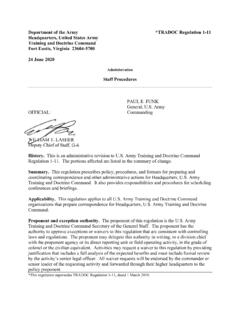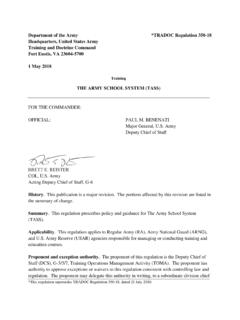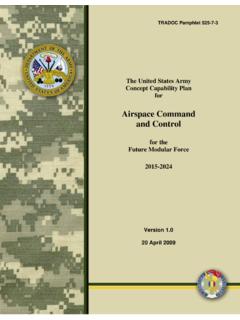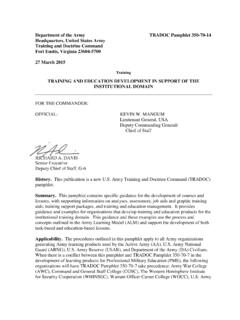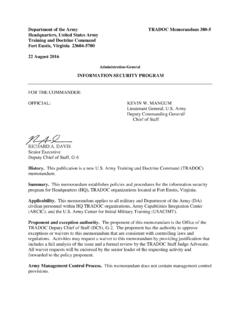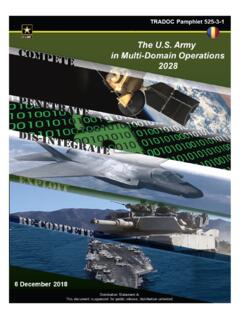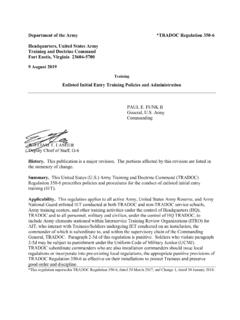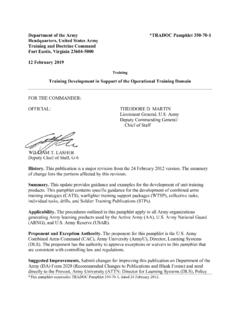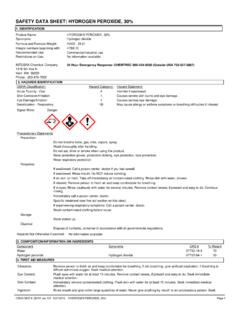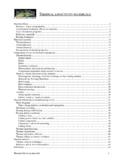Transcription of PREVENTION OF HEAT AND COLD CASUALTIES
1 Department of the Army *TRADOC Regulation 350-29 Headquarters, United States Army Training and Doctrine Command Fort Eustis, Virginia 23604-5700 18 July 2016 Training PREVENTION OF heat AND COLD CASUALTIES FOR THE COMMANDER: OFFICIAL: REX A. SPITLER Major General, Army Deputy Chief of Staff RICHARD A. DAVIS Senior Executive Deputy Chief of Staff, G-6 History. This publication is major revision. The portions affected by this revision are listed in the summary of change. Summary. This regulation prescribes policy and provides guidance to commanders in preventing environmental ( heat or cold) CASUALTIES . Applicability. This regulation applies to all Active Army and Reserve component training conducted at service schools, Army training centers, or other training activities under Headquarters, Army Training and Doctrine Command (TRADOC) control. Proponent and exception authority. The proponent for this regulation is the Deputy Chief of Staff, TRADOC.
2 The proponent has the authority to approve exceptions or waivers to this regulation that are consistent with controlling law and regulations. Army management control process. This regulation does not contain management control provisions. Supplementation. Supplementation of this regulation and establishment of command and local forms are prohibited without prior approval from the Command Surgeon s Office, TRADOC, ATTN: ATBO-M, 950 Jefferson Avenue, Fort Eustis, Virginia 23604-5750. *This regulation supersedes TRADOC Regulation 350-29, 6 July 2012. TRADOC Regulation 350-29 2 Suggested improvements. Users are invited to send comments and suggested improvements on DA Form 2028 (Recommended Changes to Publications and Blank Forms) through channels to Command Surgeon s Office, TRADOC, ATTN: ATBO-M, 950 Jefferson Avenue, Fort Eustis, Virginia 23604-5750. Suggested improvements may also be submitted using DA Form 1045 (Army Ideas for Excellence Program (AIEP) Proposal). Availability.
3 This publication is distributed solely through the TRADOC Homepage at Summary of Change TRADOC Regulation 350-29 PREVENTION of heat and Cold CASUALTIES This major revision, dated 18 Jul 2016 - o Adds requirements related to the heat illness PREVENTION subcommittee of the executive safety council; and to ensure assigned safety and medical professionals are familiar with both safety and medical terminology and reporting requirements (paras 1-3b, c, and d). o Adds requirements for commanders at brigade and unit level to establish standing operating procedures to incorporate requirements/procedures contained in this regulation (paras 1-3e(1) and 1-3f(2). o Replaces references to Commander's, Senior NCO's and Instructor's Guide to Risk Management of heat CASUALTIES with content in Appendix B. o Replaces references to Unit Leader s and Instructor s Risk Management Steps for Preventing Cold CASUALTIES with content Appendix C. o Aligns informational matter with deliberate risk management processes, and consolidates informational matter into Appendixes B and C.)
4 O Updates and incorporates Deliberate Risk Assessment factor worksheets into risk management appendixes B and C. o Reorders appendixes (control measures first, then treatment measures) (apps B and C). o Aligns instructions on use of iced sheets with Training Circular (First Aid) (paras B-2b(2)(d) and F-1c(2)). o Removes references to use of parachute ( 550 ) cord for marking Soldiers who are at risk for heat and cold injury, and monitoring hydration status (app E). o Incorporates safety-related terminology and reporting requirements (app G). o Updates terminology and references throughout. TRADOC Regulation 350-29 3 Contents Page Chapter 1 Introduction .. 5 1-1. Purpose .. 5 1-2. References .. 5 1-3. Responsibilities .. 5 Chapter 2 heat illness risk basics and training resources .. 8 2-1. Basics of heat illness 8 2-2. heat illness PREVENTION training .. 9 Chapter 3 Cold injury risk basics and training resources .. 10 3-1. Basics of cold injury risk .. 10 3-2. Cold injury PREVENTION training.
5 11 Appendix A References .. 11 Appendix B heat Illness Risk Management and Casualty Identification and treatment .. 13 Appendix C Cold Injury Risk Management and Casualty Identification and treatment .. 26 Appendix D Instructions on use of the wet bulb globe temperature (WBGT) .. 39 Appendix E Methods for Controlling Risk of heat Illness and Cold Injury .. 41 Appendix F Use of ice packs and iced sheets .. 45 Appendix G Safety and Medical Terminology and Reporting Requirements .. 48 Appendix H Supply list .. 52 Appendix I Within-year exertional heat illness incidence .. 52 Glossary .. 53 Table List Table B-1. Work/Rest and Water Consumption .. 15 Table B-2. Continuous Work/Water Consumption Guide (without rest) .. 16 Table C-1. Wind Chill Temperature .. 28 Table C-2. Army Cold Weather Uniform and Equipment Posture 55 F to 33 F .. 31 Table C-3. Army Cold Weather Uniform and Equipment Posture 32 F to 14 F .. 32 Table D-1. WBGT Categories .. 40 Table E-1. Temperature of water and cooling time.
6 44 Figure List Figure B-1. Urine color chart .. 18 Figure B-2. Deliberate Risk Assessment Worksheet factors heat illness .. 21 Figure C-1. Clothing recommendations for physical readiness training .. 33 Figure C-2. Deliberate risk assessment worksheet factors cold injury .. 39 Figure E-1. Checking a Soldier s hydration system .. 42 Figure E-2. Prototype arm immersion cooling system units .. 43 Figure E-3. Locally-fabricated arm immersion cooling system .. 44 Figure E-4. Solar shade .. 45 Figure E-5. Misting fan .. 45 Figure F-1. Application of iced sheets .. 47 Figure I-1. Within-year exertional heat illness incidence .. 52 TRADOC Regulation 350-29 4 This page intentionally left blank TRADOC Regulation 350-29 5 Chapter 1 Introduction 1-1. Purpose This regulation prescribes policy and provides guidance to commanders for preventing environmental ( heat or cold) CASUALTIES . 1-2. References Appendix A contains required and related publications and referenced forms.
7 1-3. Responsibilities Commanders and supervisors at all levels are responsible for protecting Soldiers and civilian personnel from the adverse effects of heat and cold, and for ensuring subordinate leaders are trained in recognition and treatment of heat illness and cold injury. a. Deputy Chief of Staff, G-3/5/7. Publish tasking orders annually reinforcing the requirement to conduct heat illness and cold injury PREVENTION and treatment training (see paras 1-3b(2), 1-3d(7), and 1-3e(1) and (2) below. b. Army Training and Doctrine Command (TRADOC) Surgeon. (1) Co-chair the heat illness PREVENTION subcommittee of the executive safety council. (2) Prepare and disseminate memorandums on behalf of CG, TRADOC prompting compliance among TRADOC subordinate commands with heat illness and cold injury PREVENTION training each year. c. TRADOC Safety Director. Co-chair the heat illness PREVENTION subcommittee of the executive safety council. d. Commanders of major subordinate commands, TRADOC school/center/activity commanders and commandants, directors, and staff principals.)
8 (1) Ensure appropriate hot weather and cold weather protective items (clothing, shelter) are available to Soldiers. (2) Ensure potable (drinking) water, ice, and supplemental beverages are available to Soldiers. Plan for 3 gallons of water per day per Soldier for drinking. Consider alternating between water and carbohydrate-electrolyte beverage especially in hot and humid conditions (see para E-3 below). Note. Three gallons per day per Soldier for drinking is 12 quarts per day, the maximum ( , not to exceed); see table B-1. TRADOC Regulation 350-29 6 (3) Ensure medical support and evacuation plans are tested at least semiannually (see TRADOC Regulation (TR) 350-6, para 3-9c) and evaluate compliance with the emergency medical services (EMS) goal of injured personnel to arrive at an EMS facility within 1 hour of any incident (see TR 350-6, Appendix H-2b). (4) Establish policy for hourly measurement of wet bulb globe temperature (WBGT) when ambient temperature is over 75 F.
9 (5) Establish guidance for adjustment of training schedules, locations, and intensity, based on the prior 2 days physical activity and heat category. (6) Establish coordination between the medical treatment facility and training organizations for assistance from preventive medicine service to: (a) Present annual training (see paras 2-2 and 3-2). (b) Assist in development of local risk management worksheets (see appendixes B and C). (6) Report heat illnesses and cold injuries in accordance with TR 1-8, para 2-2a(5). (7) Report compliance with heat illness PREVENTION and treatment training prior to 15 April each year, and cold injury PREVENTION and treatment training prior to 15 October each year, to the TRADOC Surgeon at (8) Provide safety and medical professional representation to the heat illness PREVENTION subcommittee of the executive safety council. (9) Ensure assigned safety and medical professionals are familiar with both safety and medical terminology and reporting requirements (see appendix G).
10 (10) Ensure that local policy guidance includes heat illness as a risk factor throughout the year. Although the definition of heat season as 1 May through 30 September each year is generally appropriate at most US Army installations, exertional heat illnesses (EHI) are a year-round problem, with varying severity depending on the installation; approximately 17% of all EHI occur outside of the heat season (see appendix I). e. Brigade commanders. (1) Establish standing operating procedures to incorporate requirements/procedures contained in this regulation and establish techniques, protocols, and authorities for application of specific controls/mitigation measures such as those identified at appendixes E and F. (2) Conduct heat illness PREVENTION and treatment training for all subordinate leaders prior to 15 April each year. TRADOC Regulation 350-29 7 (3) Conduct cold injury PREVENTION and treatment training for all subordinate leaders prior to 15 October each year. (4) Adjust training schedules (for example, train during the cooler part of the day) and locations (for example, indoors or in the shade) as needed to protect Soldiers against extremes of heat and cold.

